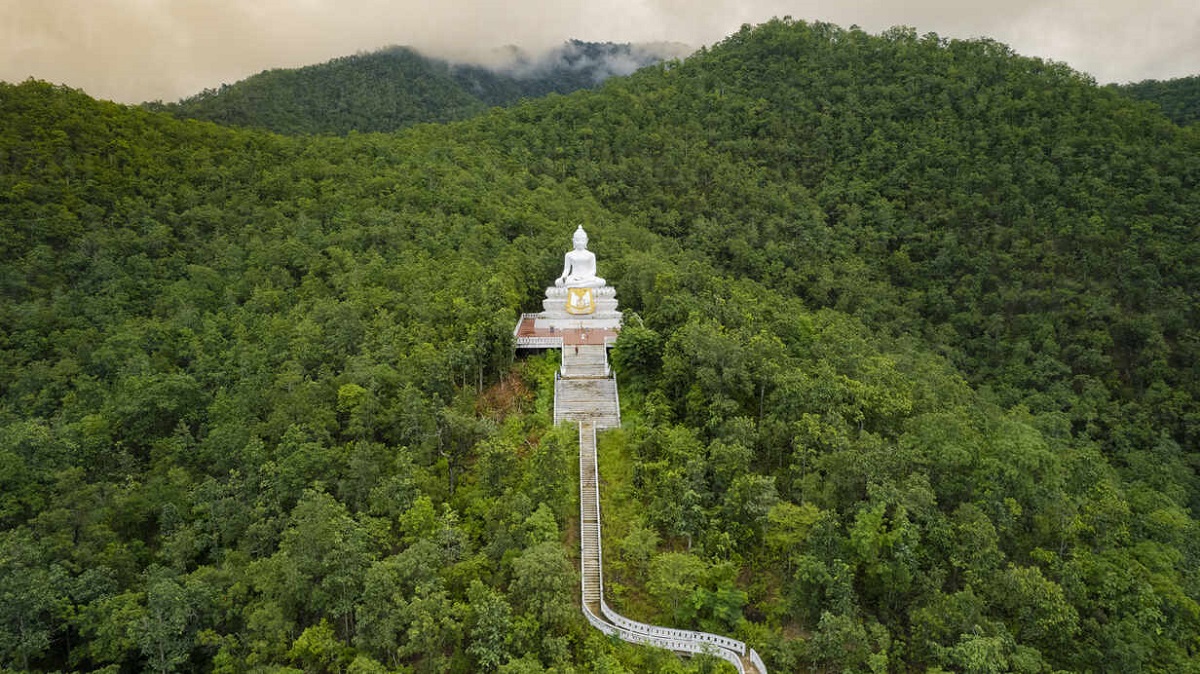Nestled in the heart of northern Thailand’s Mae Hong Son province. Pai has long been a beloved destination for travelers seeking tranquility, natural beauty, and cultural richness. Amidst the region’s lush valleys and mountainous landscapes. The Big Buddha (also known as the Wat Phra That Mae Yen) stands out as one of Pai’s most iconic landmarks. This impressive structure is not only a significant religious site but also offers stunning panoramic views of the surrounding countryside. In this article, we’ll delve into the story of the Big Buddha, what to expect during a visit, and why this site should be on every traveler’s Pai itinerary.
The Story Behind the Big Buddha in Pai
The Big Buddha Pai, or Phra Phutthatham Maha Pi, is a relatively recent addition to Pai’s landscape, constructed in the early 2000s. Perched atop a hillside at the Wat Phra That Mae Yen temple complex, this grand statue has quickly become a symbol of peace and spirituality in the area. Standing 30 feet tall and cast in a gleaming white material, the Buddha overlooks the Pai valley, emanating a sense of calm that befits its serene location. The temple site itself, Wat Phra That Mae Yen, has existed for many years and is well-loved by the local community, who often visit for meditation, prayer, and contemplation.
The Big Buddha statue, however, is a newer feature intended to enhance the temple’s spiritual allure and create a place for both locals and visitors to find peace. While relatively modern, the statue has become a prominent attraction that represents the values of Buddhist teachings and Thai cultural heritage.
Getting to the Big Buddha
Getting to the Big Buddha is part of the adventure. Located about 2 kilometers east of Pai’s town center, it’s easily accessible by motorbike, bicycle, or car. The journey to Wat Phra That Mae Yen is scenic, winding through picturesque landscapes of fields, mountains, and quaint villages.
Once you arrive at the foot of the temple, you’ll need to climb approximately 353 steps to reach the Big Buddha itself. The stairway, lined with traditional Thai decor, provides a gradual build-up to the stunning views and peaceful ambiance at the top. Although the climb might be a bit challenging for some. Most travelers find it manageable, and there are several resting spots along the way. Remember to bring water, a hat, and sunscreen if you’re visiting on a sunny day. As the stairs are often exposed to direct sunlight.
What to Expect During Your Visit
As you approach the Big Buddha Pai, you’ll be struck by its imposing height and serene expression. The white statue gleams against the greenery of the hill, adding to its sense of calm and reverence. This sacred site holds significance for both Buddhists and travelers from around the world. Making it a place of cultural exchange and mutual respect.
The top of the hill offers some of the best panoramic views in Pai. From here, you can see the rolling hills, forested mountains, and expansive farmland that define the landscape of northern Thailand. Many visitors choose to visit in the late afternoon, as the setting sun casts golden hues over the valley, creating an almost magical atmosphere. Sunrise and sunset are popular times for photographers who want to capture the Buddha against the changing colors of the sky.
During your visit, remember that the Big Buddha is an active religious site. Proper attire is essential out of respect for the customs of the temple and its visitors. It’s recommended to wear clothing that covers your shoulders and knees. Many people take a few minutes to sit and meditate or reflect in the peaceful atmosphere of the temple.
The Spiritual Significance of the Big Buddha
For the local community, the Big Buddha is more than just a statue. It’s a symbol of peace, reflection, and harmony with nature. Thai Buddhism places a strong emphasis on inner peace, mindfulness, and respect for all living things. Values that align beautifully with the quiet, undisturbed surroundings of Pai.
Visitors often report feeling a deep sense of calm and contemplation as they stand before the Big Buddha, away from the hustle and bustle of daily life. The site serves as a reminder of the importance of mindfulness, simplicity, and the beauty found in nature. It’s common to see people practicing meditation or simply sitting quietly, absorbing the peaceful ambiance.
Practical Tips for Visiting
- Best Time to Visit: Early morning or late afternoon for cooler weather and a quieter atmosphere. Sunset is particularly stunning from the top of the hill.
- Dress Code: Wear respectful attire. As with most Thai temples, it’s recommended to cover shoulders and knees. Sarongs are often available at the base of the temple if you need to cover up.
- What to Bring: Comfortable walking shoes, water, sunscreen, and a camera. The steps can be strenuous, so proper footwear is recommended.
- Entrance Fee: There’s typically no entrance fee for visiting the Big Buddha. Though donations to support temple maintenance are always appreciated.
- Respect the Culture: Remember that the Big Buddha is a religious site. Be mindful of noise levels, and avoid any actions that may be seen as disrespectful.
Why the Big Buddha Should Be on Your Pai Itinerary
The Big Buddha in Pai offers a unique blend of cultural immersion, spiritual significance, and natural beauty. It’s an experience that goes beyond sightseeing, inviting travelers to reflect and find peace amidst Pai’s breathtaking landscapes. For those seeking a deeper connection to Thai culture, Buddhism, or even just a moment of introspection, a visit to this site is highly rewarding.
Beyond the physical attraction of the Big Buddha Pai, it’s the atmosphere of reverence and calm that stays with visitors long after they leave. With each step up the hill, visitors shed a bit of their worries and are rewarded with a sense of tranquility at the top. Whether you’re an avid photographer, a cultural enthusiast, or a spiritual seeker. The Big Buddha is a must-see destination in Pai.
Conclusion
In conclusion, the Big Buddha Pai stands as a testament to Thailand’s spiritual heart and scenic charm. From its breathtaking views to its sense of serenity. It’s an experience that captures the essence of Pai and leaves an impression on every visitor who makes the journey.




